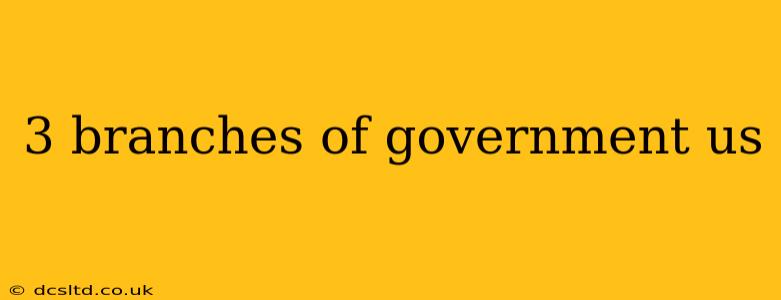The United States operates under a system of government known as a federal republic, characterized by a separation of powers among three distinct branches: the legislative, the executive, and the judicial. This intricate balance of power is designed to prevent any single branch from becoming too dominant and to protect the rights and liberties of its citizens. This article will explore each branch, their functions, and the checks and balances that ensure a stable and functioning democracy.
What are the 3 branches of the US government?
The three branches of the US government are:
- Legislative Branch: This branch is responsible for making laws. It's comprised of the Congress, which is further divided into the Senate and the House of Representatives.
- Executive Branch: This branch is responsible for enforcing laws. It is headed by the President of the United States, who is also the Commander-in-Chief of the armed forces.
- Judicial Branch: This branch is responsible for interpreting laws. It is headed by the Supreme Court and includes a system of lower federal courts.
Let's delve deeper into the specifics of each branch.
What is the legislative branch and what does it do?
The legislative branch, Congress, holds the power to create laws. This process typically begins with the introduction of a bill in either the House or the Senate. The bill then undergoes committee review, debate, and potential amendment before being voted on by each chamber. For a bill to become law, it must pass both the House and the Senate and then be signed by the President. If the President vetoes the bill, Congress can override the veto with a two-thirds vote in both chambers.
What are the powers of Congress?
Congress's powers are extensive and are outlined in Article I of the Constitution. These include:
- Declaring war: Only Congress has the power to declare war.
- Raising and spending money: Congress controls the nation's budget and has the power to tax.
- Regulating commerce: Congress regulates interstate and international trade.
- Establishing post offices and roads: This reflects the early importance of communication and infrastructure.
- Making all laws necessary and proper for carrying out its powers: This "Necessary and Proper Clause" allows Congress flexibility in implementing its enumerated powers.
What is the executive branch and its responsibilities?
The executive branch, headed by the President, is responsible for implementing and enforcing the laws passed by Congress. The President also acts as the head of state, representing the United States in international affairs. The executive branch also includes the Cabinet, composed of various departments (e.g., Department of Defense, Department of State) responsible for specific areas of governance.
What are the powers of the President?
The President's powers are significant and are outlined in Article II of the Constitution. Key powers include:
- Veto power: The President can veto bills passed by Congress.
- Commander-in-Chief: The President commands the armed forces.
- Making treaties: The President negotiates and signs treaties with other countries, subject to Senate ratification.
- Appointing federal judges and officials: The President nominates judges and other officials, subject to Senate confirmation.
- Granting pardons: The President can pardon individuals convicted of federal crimes.
What is the judicial branch and how does it function?
The judicial branch, headed by the Supreme Court, interprets the laws passed by Congress and enforced by the executive branch. Its primary role is to ensure that laws are constitutional. The Supreme Court has the power of judicial review, which allows it to declare laws unconstitutional. This system of checks and balances prevents the other branches from overstepping their authority.
What is the role of the Supreme Court?
The Supreme Court's role is paramount in upholding the Constitution. It decides cases involving:
- Constitutional questions: Determining whether laws violate the Constitution.
- Disputes between states: Resolving conflicts between different states.
- Cases involving federal law: Interpreting and applying federal laws.
How do the three branches check and balance each other?
The separation of powers is further strengthened by a system of checks and balances. Each branch has certain powers that can limit the power of the other two. For example:
- Legislative checks on Executive: Congress can impeach and remove the President, override a presidential veto, and approve presidential appointments.
- Legislative checks on Judicial: Congress can impeach and remove federal judges, and it determines the size and jurisdiction of the federal courts.
- Executive checks on Legislative: The President can veto legislation passed by Congress.
- Executive checks on Judicial: The President appoints federal judges.
- Judicial checks on Legislative: The Supreme Court can declare laws passed by Congress unconstitutional.
- Judicial checks on Executive: The Supreme Court can declare actions by the President unconstitutional.
This intricate system of checks and balances ensures no single branch becomes too powerful, thereby safeguarding the principles of democracy and individual liberties enshrined in the US Constitution.
This comprehensive overview provides a solid understanding of the three branches of the US government, their functions, and their crucial interconnectedness. Understanding this system is key to comprehending the workings of American democracy.
